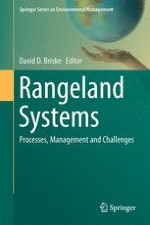Open Access 2017 | Open Access | Buch

Rangeland Systems
Processes, Management and Challenges
herausgegeben von: David D. Briske
Verlag: Springer International Publishing
Buchreihe : Springer Series on Environmental Management
Open Access 2017 | Open Access | Buch

herausgegeben von: David D. Briske
Verlag: Springer International Publishing
Buchreihe : Springer Series on Environmental Management
This book is open access under a CC BY-NC 2.5 license.
This book provides an unprecedented synthesis of the current status of scientific and management knowledge regarding global rangelands and the major challenges that confront them. It has been organized around three major themes. The first summarizes the conceptual advances that have occurred in the rangeland profession. The second addresses the implications of these conceptual advances to management and policy. The third assesses several major challenges confronting global rangelands in the 21st century. This book will compliment applied range management textbooks by describing the conceptual foundation on which the rangeland profession is based. It has been written to be accessible to a broad audience, including ecosystem managers, educators, students and policy makers. The content is founded on the collective experience, knowledge and commitment of 80 authors who have worked in rangelands throughout the world. Their collective contributions indicate that a more comprehensive framework is necessary to address the complex challenges confronting global rangelands. Rangelands represent adaptive social-ecological systems, in which societal values, organizations and capacities are of equal importance to, and interact with, those of ecological processes. A more comprehensive framework for rangeland systems may enable management agencies, and educational, research and policy making organizations to more effectively assess complex problems and develop appropriate solutions.